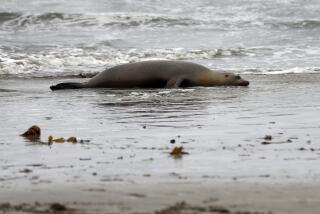San Nicolas Sea Otter Experiment in Trouble : Wildlife: Most of the 137 mammals transplanted to the island are gone. Two state agencies might kill the program.
An experiment to establish a new colony of California sea otters at San Nicolas Island is in jeopardy, wildlife scientists say.
Over the last three years, 137 otters captured in the Monterey and Big Sur area have been moved to the barren island 60 miles off the coast of Ventura in the hope that they would stay there and reproduce.
But only 13 of the transplanted otters--along with two baby otters born since the experiment started--can now be found anywhere near the island.
Instead of enjoying the island’s plentiful kelp beds and abundant sea urchins and abalones as wildlife officials believed they would, 20 of the island otters swam about 200 miles across open ocean back to their previous homes.
Another 15 have been found dead, one discovered on the shore of Point Mugu shot and wrapped in chains in 1987.
But the great majority of the furry mammals--moved to San Nicolas to avert extinction in the event of a major oil spill in Northern California--are simply gone and unaccounted for.
“It’s always sad when a research project goes awry,” said Ron Britton, the U.S. Fish and Wildlife Service biologist charged with developing the oil-spill contingency plan to save California otters.
“From the very first, the program hasn’t gone the way it was planned,” said Carl Benz, sea otter recovery coordinator with the service.
That may well spell doom for the project.
“There is not persuasive evidence to continue the program,” Benz said.
Benz and his team began this month to study whether to recommend that the otter translocation program be dropped. But they don’t have the final word.
That comes from the California Fish and Game Commission and the Coastal Commission, which will meet jointly in August to decide the issue.
The options are three:
* Capture the remaining otters and return them to their main herd;
* Continue moving up to 70 Northern California otters to the island each year;
* Leave the 15 otters at the island and let them be.
There has been strong opposition to the otter colony from commercial fishermen since the experiment started, and fishing interests still argue that there is no need for a colony on San Nicolas.
The fishermen argue that the California sea otter is the same as the Alaska sea otter, whose population numbers 200,000, and is not a threatened species as defined by law. Their position is that an oil spill in Northern California would not threaten the species.
Wildlife biologists disagree. The California sea otter is separate, they say, and worth saving.
They have spent $3 million since 1987, including staff time, trying to establish the alternative colony at San Nicolas, hoping that it would grow eventually to a few hundred California otters.
There, in theory, the species would be safe if an oil tanker accident wiped out the main population of 2,000 otters that now frolics along the Northern California coast.
Once plentiful along the West Coast, the otter population was nearly made extinct by fur traders at the turn of the century. The population was still declining in 1987 but has since begun increasing a small percentage each year, Benz said.
Otters are members of the weasel family. They forage and eat off and on for about nine or 10 hours a day and rest for about eight hours a day, often floating on their backs with kelp wrapped around them as an anchor. The rest of the time they play and socialize.
“We see them on the kelp beds, quiet, with their eyes closed for about 40 minutes at a time,” Britton said. “Then they wake up, stretch, roll over and go back to sleep for another half-hour.”
When they started the program, scientists were relatively naive about otters, their habits and their preferences, biologists say.
For instance, they believed three years ago that the otters had no homing instinct. But since 20 of them made the 200-mile trip over open ocean back home, scientists have changed their thinking.
“It’s a burning research question how they can do it,” Britton said. “They have to swim open ocean, they have to eat and they have to navigate. If you can figure out how they do that, we have a job for you.”
Wildlife biologists also believed--and assured concerned fishermen--that the otters would not swim the 60 miles across fertile commercial fishing grounds to the Ventura County shoreline.
But in 1988, an otter was spotted at Channel Islands Harbor. At the time, wildlife officials said that based on the kind of tag it was wearing it was not from San Nicolas. But it is now believed that the otter came from the new colony, said Gregory Sanders, a Fish and Wildlife biologist.
In 1987, scientists were certain that the otters would love San Nicolas.
“We thought it would be like putting a kid in a candy store,” Benz said. Instead, dozens of the mammals left or are otherwise unaccounted for.
And there are the dead animals, some caught in nets, some victims of malnutrition, others that perished of unknown causes. There is still a $10,000 reward in connection with the shooting of the one otter in 1987.
Britton said the new information that biologists have gleaned from the experiment, particularly on how to capture and tag otters, will be useful, regardless of whether the program continues at San Nicolas.
While officials take a generally pessimistic view of the chances that the otter colony on San Nicolas can be saved, they have not reached a final decision and they hold out some hope.
It would be difficult to capture the remaining otters and move them back to Northern California, officials say, and it’s not likely that they will receive permission to continue bringing more otters down from Northern California.
That leaves the option of scaling back the experiment and limiting it to the small group of otters that now remains at San Nicolas.
Benz said the fact that two pups have been born on the island, including one that has already survived to weaning, is a good sign that a permanent colony might some day be established there.
“Now we’re thinking maybe we should just let them be,” he said.
More to Read
Sign up for Essential California
The most important California stories and recommendations in your inbox every morning.
You may occasionally receive promotional content from the Los Angeles Times.










